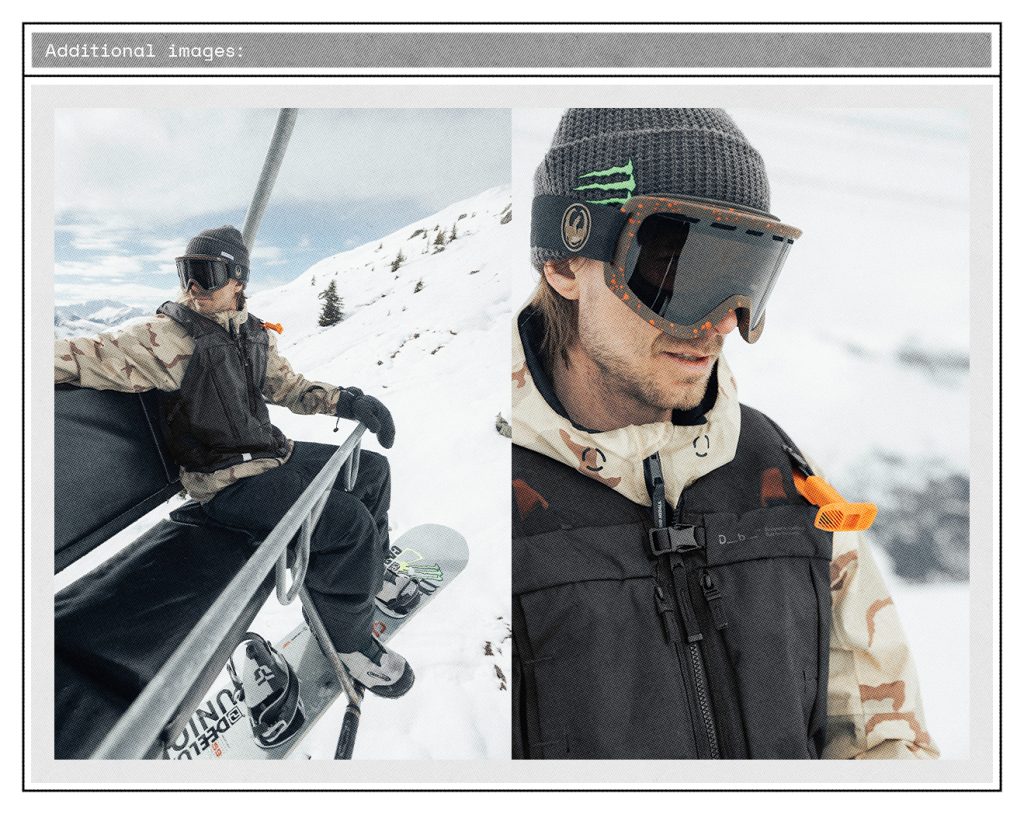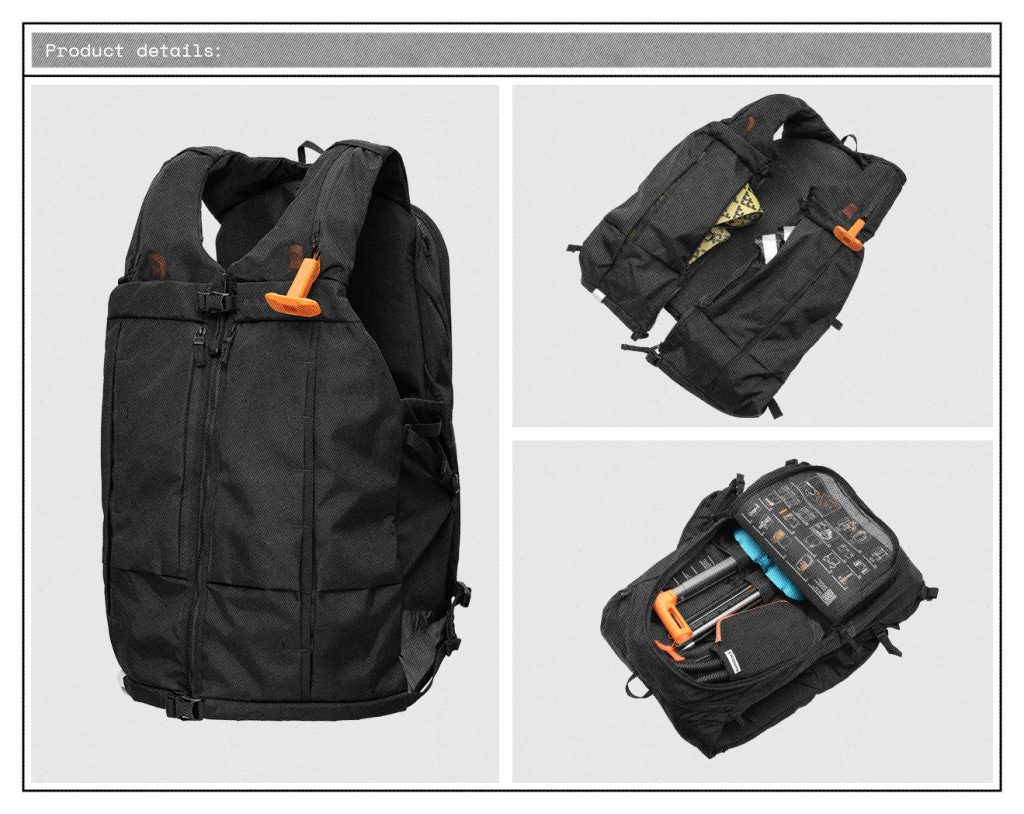Get to know ACM’s new client, Safeback, and the avalanche rescue innovation that’ll change the way we ride
Is there ever a right time to talk scary avalanche survival statistics? Probably not. Bit of a buzz flusher. So we’ll spare you the number of minutes you have to get out alive before asphyxiation seals the deal, the average speeds you’d be travelling beneath the white stuff, and a link to that video from the guy who JUST. KEEPS. ON. FILMING. as one tears towards him in Kyrgyzstan. Let’s leave it at: if there’s even a microbe of a chance that 500kg per cubic metre of moving frozen water and mountain debris could swallow you up, you better hope you and those around you have the right kit to get you outta there.
For the past two decades, avi kit has primarily fallen into the “and those around you” side of the equation. Transceivers, probes, and shovels are all widely available and all effective rescue essentials… when those topside of the slide can get to the victim within the magic survival window. Progressions in tech for those beneath the surface have been far more limited; away from Black Diamond’s Avalung – which appears to have been very quietly taken off the market entirely – and airbags, the mountain sports community hasn’t had a below-the-snow innovation to grab them by the eyes and ears in years.
And if you think we’re about to drop the most predictable “until now!” key change of your day, then you’d be absolutely right.
Safeback deserve everything that’s coming to them in 2024 and beyond. Before even launching their first avalanche survival system, SBX, they bagged the coveted ISPO award in 2022, marking it as one of the most innovative products set for market this winter. It’s just a small whiff of how huge *checks notes, takes big breath*“the world’s first active air supply system that enables people to continue breathing even when buried in the snowpack – and without a mouthpiece” *gasps* will be for our mountain cultures.
And we’re chuffed to bits to call the team of backcountry-obsessed Norwegian engineers a new ACM client.
We nabbed co-founder and CEO, Tor Berge, and CMO, William Sherman, earlier this week, and asked them to give you a far better intro to the brand, explain why it’s got everyone so excited, and reveal where they’re taking us for our first business burrito in Western Norway…

Safeback in one sentence. Let’s go.
William: “Safeback is increasing the margins of survival for avalanche victims under the snow.”
And if you had two more, what would you add?
W: “Through five years of research and testing, we’ve developed a solution to the suffocation problem in avalanche burial – historically, the leading cause of death in avalanche accidents, and the main limiting factor for rescue timelines. Safeback’s first product, SBX, is designed to actively supply air for at least 90 minutes without requiring a mouthpiece, extending the possible window to be rescued alive.”
If we were to walk into the Safeback offices right now, what one thing would catch our eye?
Tor: “Our office in Bergen has a massive window right by our desks. It faces Mount Ulriken – a 643m peak that towers over the city. We have some cool things on our desks, sure, but everything justifiably gets overshadowed by the view outside of the office.”
Was there a big “eureka” moment in the SBX story?
T: “Mechanically, SBX is quite simple, but it takes advantage of one of snow’s special properties: the ability to store a continuous field of air between its ice crystals. In our earliest testing in 2018 and 2019, we were surprised by just how much air we could retrieve out of snow by burying and starting an air pump in the snowpack. Our final product takes advantage of this stored air, turning it into the victim’s air supply during burial. When activated, SBX creates just enough airflow through the snowpack to meet the medical needs of the victim to avoid asphyxia, while also preserving the battery for the longest amount of time.”
What brought ACM into your view, and more importantly, who’s your favourite member of the team so far?
W: “We don’t play favorites – everyone on the team has been great to work with so far! You were warmly recommended by our backpack partner, Db, and after seeing the work that you’ve done for them and the rest of our partner list, it was clear that it would be hard to find a more competent and passionate partner. We are only just introducing ourselves to the market, and establishing trust in our company and product is hugely important for our first year. We’ve asked ACM to find credible media outlets to cover our product story, so we can reach core backcountry enthusiasts and educate them on SBX.”
Tor, what played a greater part in the creation of Safeback: your engineering background or your love of skiing?
T: “All three founders of Safeback have backgrounds in engineering, and I was pretty much raised with skis on my feet. I regularly used avalanche rescue equipment throughout my childhood, and my education in engineering opened my eyes to the fact that most avalanche products focused on helping users above the snow make a quick rescue, while there were no innovations that would prolong the life expectancy of a victim buried below it. My connection to this problem combined with an understanding of the tech required to solve it is the main inspiration that led us to invent SBX.”

What’s the one snowboarding/skiing film that every Norwegian grew up watching?
T: “Like most Norwegians, me and my friends started skiing at a young age. Back then, we were mostly skiing rather than watching ski films. Then in 2013 we got Supervention. It was the catalyst for modern ski films here, and groundbreaking in terms of scale and reach – you could go see it in actual movie theatres. I’d say it’s still the most well-known ski film we have.”
You spoke earlier about your five years of product testing. SBX has been through a huge range of testing processes, even finding its way into the Norwegian Army’s very serious-/cool-sounding School of Winter Warfare. What specifically did they do to push it to its limits?
W: “All outdoor companies do product testing, usually through athlete networks and other commercial partnerships. Our relationship with the Norwegian military started with a research grant from the Norwegian Defence Research Establishment to help us design and supervise burial simulations under the snow for three years. After testing each prototype under the snow, the soldiers at the School of Winter Warfare also gave us structured feedback on the practicality of the system above the snow. They stress-tested every element of our protos until we came to the final version: the product we’re bringing to market this year. SBX in its current form has also been tested by more traditional snow safety testers – from mountain guides and SAR groups to pro skiers and snowboarders – but we were lucky to have access to super users at the School of Winter Warfare to help us get the foundations of our product spec absolutely right.”
Surprise! ACM is coming out to Bergen tomorrow. Where are you taking us for our “business” meeting? Backcountry lines and post-ride beers are non-negotiable.
W: “Ah, there are so many beautiful places to ski in this country. Sogndal, Romsdalen, Sunnmøre, and Lyngen are probably at the top. They’re all world class in terms of terrain and snowfall, and feature in movies like Supervention as well as a bunch of MSP films. But Voss has a special place in our hearts. It’s where we spend most of our days on the snow – be it touring, hut trips, or making the most of the resort’s night-time riding with some post-work pow laps. We can talk shop over beers and burritos at the Tre Brør café afterwards!”
Finally, what will it take to make telemark cool?
T: “Whoa, who says it isn’t? Norway is the birthplace of skiing, and the first-ever downhill/alpine/backcountry skiing was done on what we call ‘fjellski’ – Nordic skis with steel edges and leather boots with a free heel. They’re what people were skiing the most extreme mountains in Norway on for decades, way before AT bindings became so widespread. I think that history only gets cooler the further we get away from it. Our CTO, André, and I have been tele-skiing since we were kids and we still free the heel from time to time.”